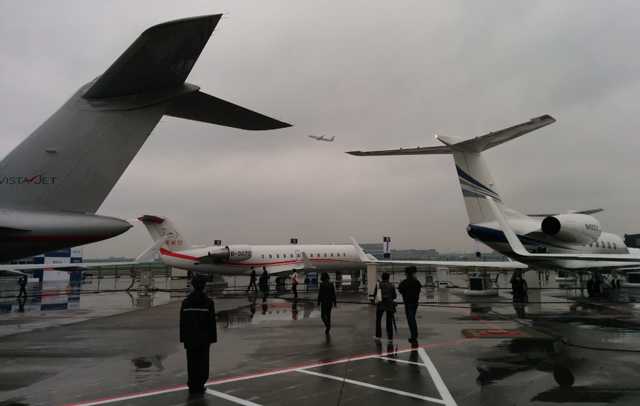Bull market peaks are often punctuated by landmark transactions. The 2014 Asian Business Aviation Conference & Exhibition (ABACE) saw one such deal, with Minsheng Financial Leasing’s jaw-dropping order for 60 Gulfstream private jets, one of the largest orders in the storied manufacturer's history. Bombardier also identified the lessor as the buyer in a late-2013 deal for 10 Challenger 350s.
The buzz at the show, held on an apron adjacent to
Not to say industry executives have become bears about
Roger Sperry, the regional senior vice-president, international sales at Gulfstream, has been doing business in
Sperry believes the market will remain dominated by large-cabin jets, but that there will be increasing interest in midsize types such as the G280, which can carry 10 passengers up to 3,600nm (6,670km), making routes such as Beijing-Singapore possible.
“Smaller companies are also likely to start looking at jets, but they will go mid-sized as they can’t afford a G450 and higher,” he adds. Furthermore, some customers are starting to use private jets to ferry around not just the chairman, but middle to senior-level executives. This shows that Chinese firms are recognising that private aircraft are, indeed, business tools, rather than a status symbol for the boss.

The overcast conditions in Shanghai for ABACE 2014 were perhaps apt for what was to follow
At Gulfstream’s rival,
“The market has slowed down, yes,” says Jacob. “It might be a temporary slowdown as we need to face some political issues over which we have no control, and we have to face the fact that people have bought many business jets over the last 10 years, and now they have to digest that.
Embraer has also noticed a distinct tightening, with deliveries and new orders declining in 2014. Apart from
It, too, notices a maturing trend, and believes that midsize jets, such as its Legacy 500 offering, will see growing interest in the country.
“Chinese customers have been more focused on the large-cabin aircraft, but in the past 12 months, purchases have tended to be more mature and focused on real usage instead of just huge cabins and long range,” says an Embraer spokeswoman.
Asian Sky Group, a Hong Kong-based consulting firm, used last year’s ABACE to launch a report about the greater
The two most popular models in the region are the Gulfstream G550 and G450, representing 30% of Greater China’s total fleet. Another trend Asian Sky observed was an increased willingness on the part of Chinese buyers to acquire used aircraft. In 2013, 47% of the aircraft delivered into the
Asian Sky’s general manager, Jeffrey Lowe, corroborates the view that the market is slowing. He contends that more private jets actually left
In years past, a favourite tactic was to set up an offshore structure to own a private jet, which was then leased to the user at an extremely low rate. Chinese officials, previously oblivious to the actual costs involved in jet ownership and usage, have become more sophisticated. They now possess a better sense of lease rates as defined by the aircraft’s overall value, and are willing to take jet owners and operators to task.
“Some Chinese owners facing a higher tax burden are changing the country of registration of their aircraft and then basing them offshore,” says Lowe. “This will cause some additional hurdles that owners will have to jump over when operating the aircraft back in
The other two factors Lowe points to for a slowing market are a general austerity campaign – a major element of which is the rooting out of corruption – and slower economic growth. Some high fliers simply cannot afford a private jet anymore.
Another area of concern, according to several people involved in
“In
The executive says a key element of the model is predicated on the leasing firms’ belief that they have sufficient market connections to move aircraft.
“Imagine an OEM sells 10 or 20 aircraft to one of those banks, but then they decide not to take title?” he asks. “It’s always a risky business. You think you have a nice orderbook, but it’s very fragile, in fact.”
Asian Sky’s Lowe expects that the current economic environment will make it a hard slog for financial firms to move private jets, especially in light of the massive influx in jets during the past few years.
“This has led to an oversupply of new-build aircraft available in the Chinese market, which could also lead to a conflict with the OEMs, as they are both pursuing the same market,” he says. “It is firmly a buyer’s market in
Ascend shows firm orders for 48 aircraft for business usage in
Gulfstream’s 60-aircraft deal with Minsheng is not included among these 48 orders, however, because it has not disclosed details of the deal, such as the number of firm orders, number of options, and delivery timeframes. A Gulfstream spokesman says the deal is on track and that the first jet will be delivered, as planned, in 2015.
This year’s ABACE promises to be another major private jet event, with all the key manufacturers bringing their best aircraft to the show. Even though few industry observers expect big, landmark orders, they all remain optimistic about
Source: Flight International



















